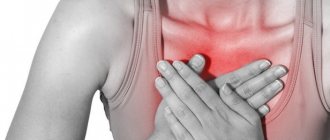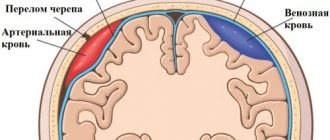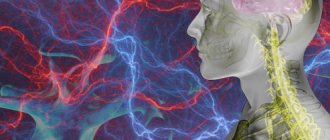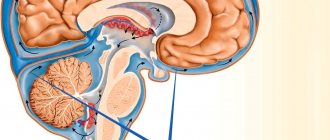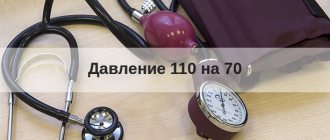Everyone has experienced headaches (cephalalgia). The cause of the occurrence can be absolutely anything: from serious disturbances in the functioning of the body to minor ones. But it is worth noting that painful pulsation in the head is a “bell” in order to go for a diagnosis.
This type of pain may indicate serious problems.
The main causes of cephalalgia
Acute pain in the head and throbbing prevents a person from living a normal life and doing business. If pain appears once, this does not necessarily indicate the presence of dysfunction in the body. In cases where a person experiences cephalalgia more and more often, and the pain lasts longer and longer, there really is a problem in the body. It needs to be eliminated, and only a specialist can handle it.
Doctors identify a number of main reasons that cause this symptom, namely:
- VSD (vegetative-vascular dystonia);
- atherosclerosis;
- sinusitis, sinusitis;
- migraine;
- eye diseases;
- hematomas;
- tumors;
- neuralgia;
- stress.
Vegetovascular dystonia
Pulsating pain is called background pain. It occurs due to a decrease in the tone of cerebral vessels, stagnation of blood, and spasms of the arteries. The difference between pain that appears due to VSD is that “jolts” do not depend on the person’s pulse.
Atherosclerosis
If a patient has problems with the vascular system, he begins to suffer from pulsation in the temporal and occipital areas of the head. But the zones can change, and the sensations can become oppressive over time.
Sinusitis, sinusitis
The reason lies in the cold you suffered, namely its complications. In order not to encounter cephalalgia, it is imperative to cure all viral and infectious diseases. The same applies to a runny nose.
Migraine
Migraine is manifested by a pulsation, which patients describe as if it were pounding right under the skin, and the pain is localized in one part of the head at the top.
Scientists have not yet proven the definitive causes of such pain, and the exact forms of manifestation of the disease have not yet been determined.
But still, there are several possible causes of migraine development, namely:
- food products (several types of cheeses and sausages);
- weather sensitivity;
- smells of ammonia, ammonia, perfume;
- serious physical activity;
- emotional outburst;
- uncomfortable body position for a long time.
A migraine can torment a person for more than one day. There are cases when the pain lasts 3 days. Most often, cephalalgia caused by this problem manifests itself in unbearably severe pain, and can go away after a few hours. Doctors note the fact that females suffer more from this.
At the end of a migraine attack, a person notes that he has severe weakness and a tendency to sleep.
Eye diseases
The following reasons that can provoke pulsation are eye diseases. A large number of people turn to specialists with complaints such as blurred vision, nausea, dizziness, photophobia, and acute pain radiating to the eye. A competent doctor will immediately determine that these are symptoms of angle-closure glaucoma - high intraocular pressure.
Cephalgia can develop due to tension in the optic nerve, which occurs due to incorrectly selected diopters of glasses or lenses. But in such cases, dizziness also appears.
Hematomas, tumors
Pulsating pain of a strong nature, which is clearly localized in one of the areas of the head, may indicate the presence of damage or a neoplasm. Also in this case, it is worth noting the presence of nausea and vomiting.
If such symptoms are noticed, you must quickly contact a specialist to diagnose a tumor or other problem and begin to treat it.
Stress
All overwork and emotional turmoil can result in severe headaches. Constant nervous tension and stress can create a “fellow traveler” for you for the whole day, namely cephalgia.
Neuralgia
Another common reason why such unpleasant sensations occur in the temple and head area. Dental problems, trigeminal neuralgia - all this provokes pain.
Other causes of cephalalgia
Osteochondrosis and a number of other problems associated with the cervical spine can provoke throbbing pain.
In winter, pulsation in the back of the head often occurs. This is explained by hypothermia and a sharp narrowing of blood vessels.
Lack of normal rest, disruption of sleep quality and routine can cause headaches.
Bad habits are also included in this list of “provocateurs”. They not only harm health, but can also cause discomfort to a person in the form of cephalgia. If a person often drank coffee and decided to abruptly stop, this can also provoke this problem, since the blood vessels are not able to return to normal so quickly.
Not everyone knows, but what we eat can also cause throbbing in our temples. These products include: chicken liver, cheeses, sausages, bacon, nuts, yogurt.
Throbbing in the neck
Pulsation in the neck often acquires great diagnostic value in various vascular and cardiac pathologies, but it can also be normal. Fluctuations in the walls of blood vessels are noticeable to the naked eye in thin adults and crying children, but this does not necessarily indicate a disease; however, it always requires clarification of the cause if the pulsation becomes constant and clearly visible to others, and accompanies headaches or arrhythmia.
In the neck, both venous pulsation is possible, most often associated with cardiac problems, and pulsation of the arteries with damage to the vascular walls themselves, hypertension, etc.
Pulsation of the cervical arteries
The most likely reasons for the very noticeable
arterial pulsation is considered to be an aortic aneurysm (local expansion of the lumen of the vessel), formed in its initial section, arch, thoracic part, arterial hypertension, thyrotoxicosis with tachycardia and hypertensive crises, aortic valve insufficiency, when part of the blood returns to the left ventricle, creating additional pulsation of the carotid arteries and their branches, visible to the naked eye.
Aortic valve insufficiency can occur in elderly people with atherosclerosis, after rheumatism or syphilitic damage to the vascular wall and valve. This defect has a rather characteristic feature - the so-called “carotid dance”, when the carotid arteries on the side of the neck contract synchronously with the rhythm of the heart. In addition to the carotid arteries, the temporal, brachial arteries, vessels of the arms and even the feet also pulsate during aortic valve insufficiency. Against the background of pulsation of the carotid arteries, swaying movements of the head appear in time with the beating of the heart.
Pulsation of neck veins
Defects such as tricuspid valve insufficiency, narrowing of the mouth of the superior vena cava, as well as severe rhythm disorders (paroxysmal tachycardia, complete AV block) provoke pulsation of the veins of the neck, however, it can also be noticed under severe stress and anxiety.
Pulsation of the cervical venous trunks often accompanies pathology that occurs with an increase in central venous pressure. In healthy people, venous pulsation can also be seen on the side of the neck 4 cm above the angle of the sternum, but only in a supine position with the head of the bed raised. When standing up, venous pulsation normally disappears, and if it persists, then one can think about the pathology of the right half of the heart with its expansion and the formation of stagnation in the veins of the systemic circulation.
Venous congestion in the neck is accompanied by expansion of the lumens of the vessels, their swelling and pulsation visible to the eye in accordance with heart contractions, which is considered to be a consequence of the return of venous blood from the ventricle to the atrium through an incompetent tricuspid valve.
The pulsation of the veins of the neck can be called a positive venous pulse; it differs from the oscillation of the walls of the carotid arteries by less force and the inability to feel it when palpated. Clinical pulsation of the veins of the neck is manifested:
- Swelling and pulsating vibrations of the venous walls in the neck to the lower jaw;
- Expansion of the lumens of the veins when inhaling, pressing on the right hypochondrium;
- Combination with swelling of the tissues of the neck, pulsating heart beats, pulsation in the epigastric region.
The most likely causes of pulsation of the venous vessels of the neck are considered to be heart defects, especially tricuspid valve insufficiency, pericarditis, heart failure with venous congestion, hemotamponade, pulmonary pathology (emphysema, pneumothorax), superior vena cava syndrome, large retrosternal goiter.
Cephalgia in children
Pulsating discomfort in a child that is not accompanied by fever, cough and runny nose should alert parents. In such cases, it is important to consult a doctor. Such manifestations may indicate problems with the child’s health.
The phenomenon can be triggered by:
- disease of the vascular system;
- neuralgia;
- migraine;
- injury;
- emotional condition;
- poor nutrition;
- the presence of provoking external factors.
What to do if there is noise in the ears and head?
Noise can be caused by various diseases and external factors. Some antibiotics, anti-inflammatory drugs, antidepressants and drugs that have a sedative effect provoke hearing impairment and ear ringing. You cannot self-medicate; you must seek medical help.
A neurologist will help with noise in the head. For consultation with an experienced specialist, you can make an appointment at the SmartMed clinic. The neurologist has extensive clinical experience and access to modern computer equipment. He will conduct a comprehensive diagnosis aimed at identifying the cause and prescribe treatment, after which all unpleasant manifestations will disappear.
Treatment can only be effective when the cause of the noise is known.
You cannot tolerate noise in your head, engage in activities that provoke its intensification, for example, parachute jumping, diving, etc. You need to give up bad habits, normalize your rest and sleep patterns, and do everything to alleviate your condition.
Cephalgia and pregnancy
Most often, girls in this position suffer from migraines, and the illness appears from physical activity, food, lack of sleep, stress, and fatigue. There are also other reasons that cause throbbing pain in women in the position:
- VSD;
- blood pressure problems;
- problems with blood supply;
- voltage;
- disorders in the brain;
- sinus inflammation;
- glaucoma.
For pregnant women suffering from cephalalgia, there are recommendations to combat discomfort, namely:
- do a light massage;
- restful sleep;
- take a contrast shower.
Regarding pain relief with medications, in this case it is important to consult a specialist, since not all painkillers are approved for pregnant women.
Treatment
Conservative therapy
The treatment plan is drawn up taking into account the nature of the disease. The following medications and non-drug methods are used:
- Migraine.
To eliminate paroxysms, non-narcotic analgesics are prescribed. For persistent attacks, blockades are performed. For intense excruciating pain and migraine status, triptans are used in tablets, rectal suppositories, and solutions for parenteral administration. The last two options allow you to solve the problem of taking the drug for persistent vomiting. - Paroxysmal hemicrania.
NSAIDs, glucocorticosteroids, and calcium channel blockers are effective. Depending on the severity of the pathology, medications are taken in short courses or continuously. - Cluster headache.
Painful attacks are eliminated with the help of triptans and applications of local anesthetics to the nasal mucosa. The effectiveness of inhalation of 100% oxygen is noted. Preventive measures in the interictal period are carried out using calcium channel blockers, hormonal, and antiepileptic medications. - Hypnic headache.
The basis of treatment is hypnotics, lithium preparations, and atypical benzodiazepines. Some researchers have reported the effectiveness of steroids and NSAIDs. Before going to bed, patients are advised to take caffeine-containing and melatonin-containing medications. - Vertebrobasilar insufficiency.
Antiplatelet agents, anticoagulants, neuroprotectors, antihypertensive, vascular drugs, exercise therapy, massage, manual therapy, hyperbaric oxygenation, magnetic therapy, laser therapy are recommended. - Tumors.
To reduce the severity of symptoms, non-narcotic and narcotic analgesics, antiemetics, glucocorticoids, and psychotropic drugs are used. Radiation and chemotherapy are carried out as part of palliative therapy or are part of complex treatment in the pre- and postoperative period. - Spinal pathologies.
Pain is eliminated with the help of oral and parenteral forms of NSAIDs, muscle relaxants, and local administration of glucocorticosteroids. They use B vitamins, neurometabolites, phonophoresis, UHF, electrophoresis, and magnetic therapy. - ENT diseases.
Treatment regimens include antibacterial, vasoconstrictor, antihistamines, physiotherapy, paracentesis of the tympanic membrane, and puncture of the paranasal sinuses.
Surgery
Treatment of primary cephalgia is only conservative. For other pathologies, the following may be indicated:
- Vertebrobasilar insufficiency
: reconstructive surgery to restore blood flow. - Brain neoplasia
: removal of cerebral tumors using traditional and minimally invasive surgical techniques. - Spinal diseases
: low-traumatic (endoscopic microdiscectomy, puncture laser vaporization) and traditional (discectomy) interventions for hernias, sometimes in combination with fixation operations. - Pathologies of ENT organs
: sanitizing surgery, mastoidotomy, frontotomy, maxillary sinusotomy, micromaxillary sinusotomy.
Elderly age
The older a person is, the more often he suffers from throbbing pain in the head, and most often this is associated with pressure and changes in the cervical spine. But there are also a number of reasons that pose a danger to older people, and these include:
- presence of a tumor in the brain;
- presence of hematomas in the brain;
- trigeminal neuralgia;
- temporal arteritis;
- intoxication;
- presence of infectious diseases;
- stroke.
Pain in the head can also be a consequence of menopause in women, weather sensitivity, which occurs in any gender, and depression.
Causes of pain by nature and location
You can determine the cause of throbbing pain in the head by analyzing the place where the patient feels it. Sensations can move around the skull, but most often they appear in a specific part.
Pain in the back of the head
Pain in this part of the skull is characteristic of high blood pressure. It also manifests itself as a pressing character, becoming more pronounced if you turn and tilt your head. It is worth noting that such a sensation in the back of the head can warn of the development of a stroke.
But there are also such provoking factors that cause pain in the back of the head as diseases of the cervical spine, namely:
- scoliosis;
- osteochondrosis.
The pain disappears when the cause is eliminated, and with it the patient feels a relieved state in the shoulders and neck, cramps disappear, and sleep improves.
Pain on the left
Characteristic of migraine. Associated symptoms:
- visual impairment;
- disturbance of consciousness;
- dizziness;
- nausea;
- photophobia;
- loss of orientation.
Pain on the right
Pulsation of a jerking nature indicates trigeminal neuralgia. The pain affects the area of the eye, forehead, temple and jaw. In cases where the pain persists, you need to consult a doctor.
Discomfort in the temporal region
A number of diseases can manifest themselves in this way, for example:
- trigeminal neuralgia;
- migraine;
- increased blood pressure;
- intoxication;
- VSD.
Frontal region
Pain in the frontal part of the head is accompanied by convulsions, disturbances of consciousness and blurred vision. They may indicate increased intracranial pressure.
Also, pain in the forehead can be caused by sinusitis, respiratory infections and eye diseases. It may also be the result of the development of a malignant brain tumor.
Discomfort when moving your head
If unpleasant pulsating sensations in the head become more pronounced while moving the head, this may indicate diseases such as:
- neuritis;
- osteochondrosis;
- inflammation of the sinuses.
Symptoms typical for such cases are:
- nausea;
- prostration;
- dizziness;
- fever;
- partial paralysis
Patients with such complaints are promptly sent for hospitalization and treatment.
Pain and nausea
The cause of such changes in the body may be food poisoning. Throbbing in the head and nausea indicate changes in the brain or nervous disorders. The attack can also be triggered by head injuries.
Pulsation in the head without accompanying pain
The most common cause of such changes is disruption of the central nervous system or cardiovascular system.
How to quickly relieve an attack of cephalalgia
In cases where a headache does not appear frequently or systematically, and a person definitely does not have diseases that can provoke it, then you can deal with the discomfort on your own. To do this, it is not necessary to use strong medications and call a doctor.
When you feel a severe headache, forget about bad habits, such as smoking and give up alcohol. You should also not apply ice or increase the dose of the analgesic yourself unless your doctor recommends it.
There are a number of actions that need to be taken so that a person with a headache begins to feel better, namely:
- Bring fresh air into the room.
- Free the patient from tight clothing and constricting jewelry, unbutton the shirt collar and raise his legs so that they are higher than head level.
- Reduce indoor lights and sounds to a minimum.
- Give water, it can also be a decoction of soothing and relaxing plants.
- Take a warm foot bath and apply a compress to your head.
- It is necessary to warm a person in cases where the pain intensifies and there is chills.
- Lightly massage the temple area, neck, head, while the person should lie down.
If the above methods do not help within 30 minutes, and only get worse, give the patient an analgesic. If this does not help, then call the ambulance doctors.
When to contact a specialist
The appearance of a throbbing headache is already a “bell” that you need to see a doctor and get checked. And few people know that there are situations that oblige the patient to contact a specialist to alleviate the condition, and sometimes even save a life.
If you notice that:
- The pain lasts for more than one hour, and medications do not help.
- The pulsation becomes stronger, despite the fact that the patient does nothing.
- Pain in the occipital region appears immediately after a person wakes up or awakening occurs due to unbearable sensations that do not allow doing anything.
- A buzzing sensation is often felt in a certain area of the head.
- The pain causes dizziness, nausea, vomiting, partial paralysis, clouding of consciousness, and inability to speak normally.
- Intense pulsating beats that do not stop for several days.
- Changes in blood pressure, which are accompanied by headaches.
- The nature of the throbbing pain constantly changes.
If you notice any of the above changes, you should immediately consult a doctor or an ambulance, as serious problems may be hidden behind this.
Methods for diagnosing headaches
At the Clinical Brain Institute, it is possible to undergo a complete examination, which will determine the cause of the throbbing headache on the right side. This is impossible at home; complex instrumental examinations will be needed to obtain a complete picture. Our center has developed special headache diagnostic schemes, adapted individually for each patient.
- Electroencephalography is a technique for assessing the functioning of various parts of the brain based on information about bioelectrical activity. It will allow you to determine areas of ischemia and necrosis, and the localization of tumors.
- Vascular ultrasound (Dopplerography) is definitely prescribed for a throbbing headache. The procedure is performed using a contrast agent. Studying the speed and characteristics of blood flow allows us to detect various vascular pathologies: aneurysms, blood clots, anomalies in the structure of arteries, which lead to ischemia (oxygen starvation) of nerve cells.
- MRI (magnetic resonance imaging) of the brain is the most informative and accurate way to diagnose tumors, circulatory disorders, and other pathologies. During the examination, you can obtain a three-dimensional image of bone and soft tissue, calculate the size of the tumor as accurately as possible and determine its location.
Some patients are recommended to undergo diagnostics in a hospital setting. At the Clinical Institute of the Brain there is the possibility of round-the-clock observation by doctors, a comfortable location during the examination period, as well as taking all necessary tests. Based on the diagnostic results, an individual treatment regimen is prescribed.

